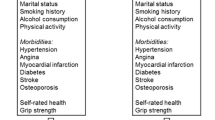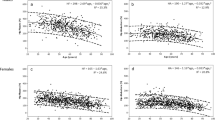Abstract
This cross-sectional study proposes two relative strength indexes in order to evaluate the risks of lower mobility in healthy older adults: 1) handgrip strength on body mass index and 2) quadriceps strength on body weight. Nine hundred and four men and women aged between 67–84 years old were tested for body composition, muscle strength and mobility function. Individuals in the lowest and middle tertiles of relative handgrip strength were respectively 2.2 (1.3–3.7) and 4.4 (2.6–7.6) more likely to have a lower mobility score. As for relative quadriceps strength, odd ratios for lowest and middle tertiles were respectively 2.8 (1.6–4.9) and 6.9 (3.9–12.1). Relative strength indexes, either using handgrip strength or quadriceps strength, are convenient to use in large scale studies and clinical practice.
Similar content being viewed by others
References
Hamerman, D., Toward an understanding of frailty. Ann Intern Med, 1999. 130(11): p. 945–950.
Statistic Canada, Disability in Canada: A 2001 Profile N 89-577-XIF. 2001.
US center for health statistics, US Vital Statistics 1986–1988. 1993: Hyattsvill (MD).
Gill, T.M., C.S. Williams, and M.E. Tinetti, Assessing risk for the onset of functional dependence among older adults: the role of physical performance. J Am Geriatr Soc, 1995. 43(6): p. 603–609.
Giampaoli, S., et al., Hand-grip strength predicts incident disability in non-disabled older men. Age Ageing, 1999. 28(3): p. 283–288.
Rantanen, T., et al., Muscle strength as a predictor of onset of ADL dependence in people aged 75 years. Aging Clin Exp Res, 2002. 14(3 Suppl): p. 10–15.
Rantanen, T., et al., Midlife hand grip strength as a predictor of old age disability. JAMA, 1999. 281(6): p. 558–560.
Visser, M., et al., Skeletal muscle mass and muscle strength in relation to lowerextremity performance in older men and women. J Am Geriatr Soc, 2000. 48(4): p. 381–386.
Visser, M., et al., Body fat and skeletal muscle mass in relation to physical disability in very old men and women of the Framingham Heart Study. J Gerontol A Biol Sci Med Sci, 1998. 53(3): p. M214–M221.
Zamboni, M., et al., The relationship between body composition and physical performance in older women. J Am Geriatr Soc, 1999. 47(12): p. 1403–1408.
LaCroix, A.Z., et al., Maintaining mobility in late life. II. Smoking, alcohol consumption, physical activity, and body mass index. Am J Epidemiol, 1993. 137(8): p. 858–869.
Launer, L.J., et al., Body mass index, weight change, and risk of mobility disability in middle-aged and older women. The epidemiologic follow-up study of NHANES I. Jama, 1994. 271(14): p. 1093–1098.
Janssen, I., Morbidity and mortality risk associated with an overweight BMI in older men and women. Obesity (Silver Spring), 2007. 15(7): p. 1827–1840.
Al Snih, S., et al., The effect of obesity on disability vs mortality in older Americans. Arch Intern Med, 2007. 167(8): p. 774–780.
Harris, T.B., et al., Waist circumference and sagittal diameter reflect total body fat better than visceral fat in older men and women. The Health, Aging and Body Composition Study. Ann N Y Acad Sci, 2000. 904: p. 462–473.
Peeters, A., et al., Adult obesity and the burden of disability throughout life. Obes Res, 2004. 12(7): p. 1145–1151.
Sturm, R., J.S. Ringel, and T. Andreyeva, Increasing obesity rates and disability trends. Health Aff (Millwood), 2004. 23(2): p. 199–205.
Grabiner, M.D. and R.M. Enoka, Changes in movement capabilities with aging. Exerc Sport Sci Rev, 1995. 23: p. 65–104.
Penninx, B.W., et al., Lower extremity performance in nondisabled older persons as a predictor of subsequent hospitalization. J Gerontol A Biol Sci Med Sci, 2000. 55(11): p. M691–M697.
Studenski, S., et al., Physical performance measures in the clinical setting. J Am Geriatr Soc, 2003. 51(3): p. 314–322.
Goodpaster, B.H., et al., The loss of skeletal muscle strength, mass, and quality in older adults: the health, aging and body composition study. J Gerontol A Biol Sci Med Sci, 2006. 61(10): p. 1059–1064.
Janssen, I., Influence of sarcopenia on the development of physical disability: the Cardiovascular Health Study. J Am Geriatr Soc, 2006. 54(1): p. 56–62.
Davis, J.W., et al., Strength, physical activity, and body mass index: relationship to performance-based measures and activities of daily living among older Japanese women in Hawaii. J Am Geriatr Soc, 1998. 46(3): p. 274–279.
Visser, M., et al., High body fatness, but not low fat-free mass, predicts disability in older men and women: the Cardiovascular Health Study. Am J Clin Nutr, 1998. 68(3): p. 584–590.
Bouchard, D.R., et al., Fat mass but no fat-free mass is related to mobility in well-functioning older individuals: Nutrition as a determinant of successful aging (NuAge): The Quebec Longidutinal Study. The Journal of Gerontology: Medical Sciences, In press.
Aubertin-Leheudre, M., et al., Effect of sarcopenia on cardiovascular disease risk factors in obese postmenopausal women. Obesity (Silver Spring), 2006. 14: p. 2277–2283.
Rantanen, T., et al., Handgrip strength and cause-specific and total mortality in older disabled women: exploring the mechanism. J Am Geriatr Soc, 2003. 51(5): p. 636–641.
Rantanen, T., P. Era, and E. Heikkinen, Maximal isometric strength and mobility among 75-year-old men and women. Age Ageing, 1994. 23(2): p. 132–137.
Rantanen, T., et al., Disability, physical activity, and muscle strength in older women: the Women’s Health and Aging Study. Arch Phys Med Rehabil, 1999. 80(2): p. 130–135.
Desrosiers, J., et al., Comparison of cross-sectional and longitudinal designs in the study of aging of upper extremity performance. J Gerontol A Biol Sci Med Sci, 1998. 53(5): p. B362–B368.
Nichols, J.F., P. Patterson, and T. Early, A validation of a physical activity monitor for young and older adults. Can J Sport Sci, 1992. 17(4): p. 299–303.
Reed, R.L., et al., A comparison of hand-held isometric strength measurement with isokinetic muscle strength measurement in the elderly. J Am Geriatr Soc, 1993. 41(1): p. 53–56.
Podsiadlo, D. and S. Richardson, The timed “Up & Go”: a test of basic functional mobility for frail elderly persons. J Am Geriatr Soc, 1991. 39: p. 142–148.
Jones, C.J., R.E. Rikli, and W.C. Beam, A 30-s chair-stand test as a measure of lower body strength in community-residing older adults. Res Q Exerc Sport, 1999. 70(2): p. 113–119.
Guralnik, J.M., et al., A short physical performance battery assessing lower extremity function: association with self-reported disability and prediction of mortality and nursing home admission. J Gerontol, 1994. 49(2): p. M85–M94.
Lin, M.R., et al., Psychometric comparisons of the timed up and go, one-leg stand, functional reach, and Tinetti balance measures in community-dwelling older people. J Am Geriatr Soc, 2004. 52(8): p. 1343–1348.
Washburn, R.A., et al., The Physical Activity Scale for the Elderly (PASE): development and evaluation. J Clin Epidemiol, 1993. 46(2): p. 153–162.
Fillenbaum, G.G. and M.A. Smyer, The development, validity, and reliability of the OARS multidimensional functional assessment questionnaire. J Gerontol, 1981. 36(4): p. 428–434.
Ramsay, S.E., et al., The relations of body composition and adiposity measures to ill health and physical disability in elderly men. Am J Epidemiol, 2006. 164(5): p. 459–469.
Manini, T.M., et al., Knee extension strength cutpoints for maintaining mobility. J Am Geriatr Soc, 2007. 55(3): p. 451–457.
Guralnik, J.M., et al., Lower-extremity function in persons over the age of 70 years as a predictor of subsequent disability. N Engl J Med, 1995. 332(9): p. 556–561.
Ostir, G.V., et al., Lower body functioning as a predictor of subsequent disability among older Mexican Americans. J Gerontol A Biol Sci Med Sci, 1998. 53(6): p. M491–M495.
Guralnik, J.M., et al., Validation and use of performance measures of functioning in a non-disabled older population: MacArthur studies of successful aging. Aging (Milano), 1994. 6(6): p. 410–419.
Seeman, T.E., et al., Predicting changes in physical performance in a high-functioning elderly cohort: MacArthur studies of successful aging. J Gerontol, 1994. 49(3): p. M97–M108.
Baumgartner, R.N., et al., Epidemiology of sarcopenia among the elderly in New Mexico. Am J Epidemiol, 1998. 147(8): p. 755–763.
Janssen, I., et al., Skeletal muscle cutpoints associated with elevated physical disability risk in older men and women. Am J Epidemiol, 2004. 159(4): p. 413–421.
Rantanen, T., Muscle strength, disability and mortality. Scand J Med Sci Sports, 2003. 13(1): p. 3–8.
Guralnik, J.M., L.P. Fried, and M.E. Salive, Disability as a public health outcome in the aging population. Annu Rev Public Health, 1996. 17: p. 25–46.
Author information
Authors and Affiliations
Corresponding author
Rights and permissions
About this article
Cite this article
Choquette, S., Bouchard, D.R., Doyon, C.Y. et al. Relative strength as a determinant of mobility in elders 67–84 years of age. A nuage study: Nutrition as a determinant of successful aging. J Nutr Health Aging 14, 190–195 (2010). https://doi.org/10.1007/s12603-010-0047-4
Received:
Accepted:
Published:
Issue Date:
DOI: https://doi.org/10.1007/s12603-010-0047-4




